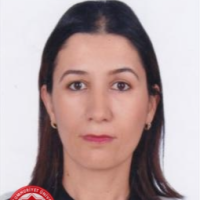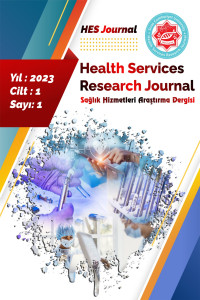Review
Research Article
Clinical Research
Aim & Scope
The journal aims to share experimental and theoretical knowledge in multidisciplinary fields related to health services. In addition, the journal also aims to contribute to the increase of scientific research in these fields and to present the latest scientific developments to the readers.
The scope of the journal includes studies in multidisciplinary fields related to health services.
Author Guidelines
Authors should be careful about the following issues:
Please prepare your article according to the journal's rules.
In particular, please make sure that the references section is prepared following the journal rules.
Please be aware that submissions that are not prepared according to the journal rules will cause delayed evaluation.
Please make sure that the references in your submission and the reference section are compatible.
We recommend that you check your submission carefully for references before sending it.
Please check your submission for a similarity index before submitting.
Please note that a high similarity index will result in the rejection of your direct submission according to the journal rules.
The author is required to prepare a new manuscript according to the rules given below before online submission. Please prepare your article by carefully following the rules below.
Use only the 12-point Times New Roman font for the text and the symbol font only for mathematical symbols.
The text should be justified on both sides.
Instead of underlining text, use italics, bold, or bold italics.
Use double-line spacing.
Leave blank lines between paragraphs and sections.
Leave a blank line between the section title and the text.
Leave only one space after a full stop.
In Turkish texts, it is compulsory to use a comma as a decimal symbol and a dot as a digit grouping symbol.
The manuscript should be prepared in A4 (210 × 297 mm) page structure using double line spacing, and margins of 2.5 cm in each direction should be given. All pages should be numbered, line numbers should be applied continuously on the left margin, and research articles should consist of the following sections;
Turkish and English Abstract, Introduction, Materials and Methods, Results and Discussion, Acknowledgements, References, Figures, Tables.
The title of the article should be written in 14-point font size, bold and centered, and the initials of the words other than conjunctions should be capitalized. In 12-point font size, full names of the authors (not abbreviated), the superscript numbering should be used for address information at the end of the surname, address information should be placed after the author names, and full contact information of the corresponding author should be included.
The abstract of 300 words in Turkish and English should not include statistical significance data (such as P<0.05) and reference information.
Reference list
The reference list is at the end of your work and gives full details of everything you cite in the text, alphabetized by the author's surname.
All sources must be cited consistently. Choose from the list of sources below, the examples given provide a guide to the format and punctuation you should use.
Citation in Text
In Turkish articles;
(Surname, 2013; Surname et al., 2015; Surname et al., 2016; Surname and Surname, 2017)
Journal Article (Printed)
Surname A, Surname A, Dogan AA, Surname SS, Surname S. 2010. Article English title, Journal name, ??: ??: ???-????. doi:
Journal Article (Electronic)
Surname A, Surname A, Dogan AA, Surname SS, Surname S. 2010. Article English title, Journal name, ??: ???-?????. doi:
Book
Surname A. 1993. Book English Name,: Publisher. ISBN:
Book Chapter
Surname A, Last Name A. 2017. In: Surname S, Surname AS (editors), Title of the Book in English, Publisher. pp. ???-?????. ISBN:
Conference Proceedings
Surname A, Soy A, Dogan AA, Soy SS, Soy S. 2016. English Title of Presentation, In: Surname S, Surname AS (editors). English title of the conference, Place, Date and Year, Publisher., pp. ???-?????.
Thesis
Surname A. 2011. English Title of Thesis, Ph.D. Dissertation. English Name of the Institute, English Name of the University, Place, Country
Internet
FAO, 2017. Food and Agriculture Organization of the United Nations. FAOSTAT. Available from: http://www.fao.org/faostat/en/#data/QC [Accessed 28 February 2020]
Abbreviations and units
Internationally recognized abbreviations should be used. Some examples are given below.
Meter: m, Kilogram: kg, Second: s, Minute: min, Ampere: A, square meter: m2, cubic meter: m3, Hertz: Hz
Tables, figures, and drawings
When presenting data, authors should anticipate the limitations imposed by the size and layout of the journal. Large and complex tables, figures, and maps should be avoided in the main manuscript, but may be included in a data appendix for use by reviewers.
Figures should be saved in a neutral data format such as JPEG, TIFF, or EPS. PowerPoint and Word graphics are not suitable for reproduction. Please do not use pixel-oriented programs. Scanned figures (in JPEG and TIFF formats) must have a resolution of 300 dpi (for halftones) or 600 to 1200 dpi (for drawings), depending on the reproduction size.
Tables and figures in the main text of the paper should be numbered separately according to the order in which they appear in the text.
Each table and figure should be presented on a separate page of the paper with a short and descriptive title. All text should be clearly legible, and all graphics and explanations should be easily recognizable when printed in black and white. Tables should use only horizontal lines, with only spaces to separate columns.
Notes at the bottom of each table and figure should be used to explain and indicate the source of all the data shown.
File Sizes
Manuscripts will be distributed to reviewers via the Web. However, if the files are too large, reviewers using telephone modems may experience unacceptable download delays. A number of simple tricks can be used to avoid unnecessarily large files. Do not scan pages of text. Do not scan Shapes that are printed if the original digital document is not available. If a scanned shape is unavoidable, please use Adobe PhotoShop or a similar program to edit the file and reduce the file size (not necessarily the image size) as much as possible before sending. For example, crop the image to exclude the surrounding "white space." Do not use color carelessly. Black and white drawings or grayscale figures should not be saved as color documents; this will increase file sizes without increasing the information content of the file. Do not use color unless absolutely necessary to convey information.
File format
We ask that you submit the manuscript in Microsoft Word format (.DOC). If you use another word processor, please save the final version of the paper as a Word document (using the 'Save As' option in the file menu). In this case, please double-check whether the saved file can be opened in Microsoft Word. We cannot accept Acrobat, PDF, or other text files.
Application Checklist
During the submission process, authors should check that their submissions comply with all the items in the list below. Submissions that do not comply with this guideline will be returned to the authors.
1. The submitted manuscript has not been previously published and has not been submitted to any journal for consideration for publication (a detailed explanation is given in the Author Guidelines).
2. The submission file is in OpenOffice, Microsoft Word, RTF, or WordPerfect document format.
3. URLs for existing submissions are provided here.
4. The text is in a double-spaced, 12-point font, italicized rather than underlined (with applicable URL addresses), and all figures, illustrations, and tables are placed at the end of the page. For printing, please send good-quality copies of the illustrations as attachments. If the size of the file sent is too large, the system may not receive it. In such cases, you can divide the manuscript and send the other parts as additional files, one by one.
5. In Turkish articles, it is obligatory to write all texts, including the title, in English in Graphics and Tables.
6. In Turkish texts, it is obligatory to use a comma as a decimal symbol and a dot as a digit grouping symbol.
7. The style and bibliographic requirements added here can be seen in the Author's Guide in the About the Journal section.
8. If you are submitting your manuscript to a peer-reviewed journal section, click to ensure blind review. Follow the suggestions on the Help Page completely.
Authors should pay attention to the following issues:
1. Please prepare your manuscript according to the journal's rules. Especially, make sure that the references section is prepared according to the journal rules. Please note that failure to prepare according to the journal rules will result in a late evaluation.
2. Please make sure that the references in your publication and in the reference section are compatible. We recommend that you make a careful check for references before uploading your publication.
3. Please check your work for a similarity index before uploading. Please note that a high similarity index will directly lead to the rejection of the work according to the journal's rules.
Ethical Principles and Publication Policy
The content of the journal, which is "open access," is provided free of charge to all users. Users can read, download, distribute, print, and link to the full text of the articles in the journal without permission from the publisher or author(s).
For the manuscripts sent to our journal for evaluation, no guarantee of number, referee, or duration can be given, and the publication conditions are completely dependent on the completion of the referee process and the permission of the authorized board or commission.
Price Policy
No processing or publication fee is charged for articles submitted to the Health Services and Research Journal.
Indexes
Journal Boards
Baş Editör

Editor

Alan Editörleri







Berna BAYSAL BAKAY Sivas Cumhuriyet Üniversitesi Sağlık Hizmetleri Meslek Yüksekokulu'nda Doktor Öğretim Üyesi olarak çalışmaktadır. Araştırmaları, Tıbbi Parazitoloji alanında Protozoonlar ve Arthropodlar üzerine odaklanmaktadır.


Erdoğan Özdemir is a physics education researcher at Sivas Cumhuriyet University. He develops innovative teaching tools and investigates the role of these tools in physics teaching.


Yazım ve Dil Editörleri
Mizanpaj Editörleri

Teknik Editörler




